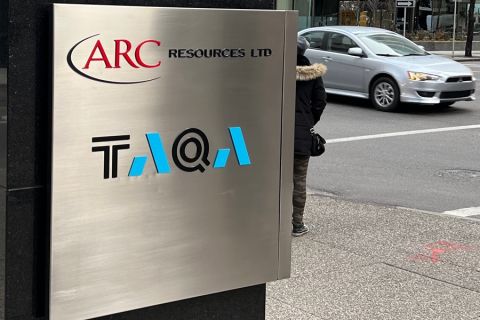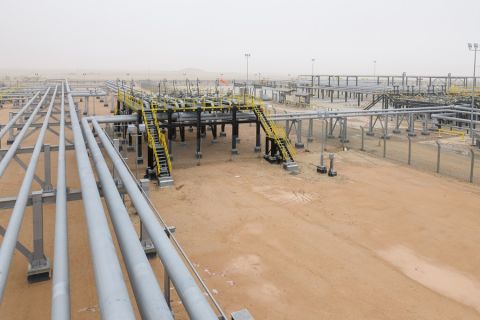Independent upstream operators need to get their product treated, processed and transported to market. That process doesn't happen automatically and, as a result, they are often forced to build midstream infrastructure themselves or to seek strategic alliances with third parties to provide midstream services. Their expectations are crucial and the stakes are high, as the success of a given field often depends on the reliability of a series of midstream assets.
Eagle Rock Energy Partners LP is a Houston-based master limited partnership which has both upstream and midstream operations. About 55% of its operating income comes from upstream assets with the rest from midstream. Its midstream operations are independent of its upstream assets and are focused primarily in the Texas Panhandle and East Texas, with the remainder in other areas.
Its upstream assets include 591 operated producing wells, with 371 billion cubic feet equivalent (Bcfe) of proven reserves, 63% of which are natural gas. About 45% of its reserves are in the Midcontinent, 30% in Alabama, 17% in East Texas and the remainder in the Permian Basin or South Texas.
The areas where Eagle Rock operates generally have adequate gathering and processing infrastructure in place. "There is generally capacity available, given our focus on development drilling activities in established oil and gas plays. We have not run into situations where there is a constraint at a plant or the inability to get a line to us in a timely fashion," says Jeff Wood, senior vice president and chief financial officer at Eagle Rock Energy Partners. "We've been very fortunate in those areas."
The majority of Eagle Rock's production has a high Btu content that requires processing to extract the liquids Btu and enhance the marketability, so about 75% to 80% of its production requires processing. In its Alabama and East Texas upstream operations, Eagle Rock's production requires treating to remove hydrogen sulfide and carbon dioxide.
In southern Alabama, where Eagle Rock has fields that account for about 20% and 25% of its overall production, it owns and operates gathering and treating and processing assets, Wood says.

An Eagle Rock Energy rig drilling in the Golden Trend in southern Oklahoma works the play. Source: Eagle Rock Energy Partners LP
Eagle Rock has grown predominately by acquisition. This growth brings with it existing contracts with midstream operators and wells that are already hooked up and producing.
"There is no need to go in and duplicate that. We certainly have the capability to lay our own gathering lines and build our own gathering and treating assets," he says. "But it doesn't make economic sense to build redundant lines and treating assets in areas where there is already an existing infrastructure in place."
As Eagle Rock drills new wells in those areas, it seeks out third-party midstream partners to hook up wells to their own treating and processing plants. Eagle Rock Energy makes a decision to build it themselves or to contract with a third-party midstream partner depending largely on how it acquires the production in the area. "It all depends on how you come about those producing properties," says Joe Schimelpfening, senior vice president for the upstream business at Eagle Rock Energy Partners.
If Eagle Rock's upstream operators were to move into a new area that has no infrastructure, it would evaluate both building out midstream assets itself and contracting with midstream partners to have an infrastructure built.
"Historically, we've kept the businesses separate, but it is certainly something we would consider," he says.
In many cases, Schimelpfening says the regions where Eagle Rock seeks to operate includes infrastructure that is owned by more than one operator. When the firm buys an existing producing lease, it usually comes with a contract in place with a midstream operator. As Eagle Rock expands in the area, it often has the opportunity to negotiate gathering and processing agreements with other midstream partners.
"The first thing we look at in areas where we operate is who has the existing processing infrastructure," says Schimelpfening. "They have a natural advantage to service our business as we drill new wells in the area."
If it is not already under an existing contract, Eagle Rock will negotiate a separate gathering and processing agreement with midstream companies. "We will talk to several companies that operate in those areas," he says.
Eagle Rock has several critical expectations of a midstream partner. "First and foremost, we look for someone who can get our wells hooked up in a timely fashion," Schimelpfening says. "Given our strong margin in the upstream business, getting those wells to sales quickly is very important to us."
In addition, Eagle Rock expects its midstream partners to access efficient treating and processing assets. "Most of the areas we drill produce rich gas that requires processing," he says.
Eagle Rock wants a midstream partner who has efficient operations with strong run times on its plants and has high product recoveries within its plants. It also expects efficient and fair commercial operations. "We want to ensure that we receive the best commercial deal in that area," Wood says.
Transparency is also important. Eagle Rock looks for a partner who can clearly show how the liquids and condensate from the production stream are allocated. "And we like to see timely and easy-to-read plant statements," Wood says.
"We don't like surprises. We value a midstream partner that has well-maintained plants with minimal interruptions in services," he says. "And we strive to meet those same expectations in servicing producers in our own midstream business."
Eagle Rock has commercial agreements in place with consumers of its gas and liquids and does not need underground storage.
Complementary divisions
J-W Energy Co. is a Dallas-based, privately held enterprise with both upstream and midstream operations that complement each other.
J-W began as an operator for oil and gas companies in 1960. It soon added compression services and has evolved into a vertically integrated oil and gas company. Its upstream operations include two major areas of operations—north Louisiana Haynesville and Barnett shale. Its midstream division, J-W Midstream Co., supports upstream operations and offers third-party gathering, compression, dehydration, treating and processing services to other upstream operators.
J-W Energy's upstream division, J-W Operating Co., has a net 154,300 acres throughout the major shale plays. Its operations have no need for natural gas storage. In the main areas where J-W Operating Co. operates, the midstream infrastructure is sufficient to ensure production can be moved.
"We have a few areas of operation in which we choose to have the gas processed for natural gas liquids (NGL) extraction. One of the main areas for this is a certain section of the Barnett shale where the Btu content is high. There are additional areas of operation that do require treating and conditioning, such as the Haynesville," says Kevin Delapp, senior business development and marketing representative for J-W Operating Company.
Brian Best, director of gas supply for J-W Midstream Co., says the company generally prefers to develop its own midstream infrastructure in areas where its upstream division has a heavy presence, provided it can do so at an effective cost of capital.
"We have always tried to leverage our midstream operations with other upstream operators. So where it made sense for them to connect to us, we would gather and treat their gas and redeliver to downstream pipelines or buy their gas," he says.
A reliable midstream partner is a key element to a successful upstream operation, he says, and J-W Energy likes its own control over operations, which it prefers over an outside company—even one with a reliable reputation.
"Most oil and gas people tend to like control, and that certainly gives us an element of control," he says. "We're all moving toward the same goals at the same pace."
At the moment, J-W Energy's upstream subsidiary uses the company's midstream subsidiary to do its gathering, treating and processing, but that is not an ironclad policy. Best says, in most cases, a new location provides a strategic opportunity to both midstream and upstream divisions of J-W and it makes sense for both divisions of the company to work together to develop and bring its production to market.
"It's a good opportunity for both of us to be there. If it makes sense for the E&P upstream side to have a development program, and there is a need for infrastructure development, then that's a great reason for us to come along with them."
If J-W Energy were to expand into a more established area that has gathering and treating assets already in place, then the company would reconsider its policy of building its own gathering and treating assets.
"That's an opportunity where we, as an enterprise, would have to think critically about how we deploy capital. If it makes sense to deploy more capital to drill more wells, rather than build gathering lines, then we would do that," he says.
As a third-party provider of midstream services to other exploration and production companies, Best says he is very familiar with their expectations. Upstream operators expect efficient midstream operators with goals that are aligned with their own. Midstream operators have to show a track record of proven services. "They need to be able to take gas when it's ready to flow," Best says.
In addition, exploration and production companies expect a midstream operator to have proven service ability with adequate capacity to move all of the production. "They need to take 100% of the gas when it's ready to go," he says.
Many upstream operators look at midstream service providers as a source of financing. These companies front a large amount of capital to provide a needed service, such as take-away capacity. In return, the upstream company gives them a stream of payments for those services over the course of time, Best says.
Upstream operators also want a midstream partner with a solid track record of reliability. The ability to offer timely gas processing and treating services is also essential, Best says.
Given the low price of methane, a good midstream processor needs sophisticated equipment operating at a competitive cost. "There is a strong emphasis on processing efficiency," he says. "Those are significant added benefits and complexities that come with liquid development."
Flexible policy
PetroEdge Energy Co. is a Houston-based upstream operator with 31,000 acres in several counties in West Virginia.
Chief executive officer Larry Richard says the company is flexible when it decides whether to build its own gathering and processing assets or to partner with a midstream provider. "Our preference is to select a strategic midstream partner to help us with the construction of our gathering and processing systems. In the absence of that, we will build our own," he says.
PetroEdge has done both. In some areas, it has built its own gathering and compression assets. In other areas, it has formed a strategic alliance with a midstream provider.
In its wet-gas areas, PetroEdge partners with Caiman Eastern Midstream LLC, whose assets were recently acquired by Williams Midstream LP, which operates the gathering and treating assets before sending products to long-distance transmission lines, Richard says. In dry-gas areas, PetroEdge partners with both M3 Midstream LLC and with Columbia Gas, a division of NiSource Inc. "We are basically flowing into three pipeline systems," he says.
In areas where it works with Columbia Gas, PetroEdge built and operates its own midstream assets. The gas from that area flows straight into a transmission line. PetroEdge does not require storage services for any of its production.
In general, when partnering with a midstream provider, PetroEdge wants to ensure it has reliability at a competitive price. "We want to ensure they can provide the capacity that we need based on what we think our development plans are, both currently and in the future," he says.
In wet gas areas, its midstream partners need to have the capability to extract the optimal amount of liquids at a competitive price. "They need to provide the complete processing solution," he says.
Value for fees
Competitive price does not necessarily mean the lowest cost of moving the product or the highest recovery of liquids. There are important trade-offs in both, and in some cases, the extra liquids obtained from a high recovery process do not offset the higher cost of extracting them.
In short, PetroEdge wants value for the fees it pays its midstream partner. "We are looking for the best processing solution at a competitive cost," he says. The midstream infrastructure in areas where PetroEdge operates is varied, with some areas constrained and others with adequate infrastructure, Richard says.
"It varies across our operating area, but on the whole it is becoming more adequate. But I still have an area where we can't move gas at all," he says. "In north-central West Virginia, there is no good outlet for moving a reasonable amount of gas whatsoever." In Upshur, Barbour, Taylor and Lewis counties, there is no available capacity in the legacy pipeline systems and no new pipelines have been laid as of yet, he says.
In areas where it partners with Caiman-Williams, the midstream infrastructure is more than adequate. In other areas, Richard calls the infrastructure "workable."
In general, Richard believes that as the Marcellus has developed, finding competitive transportation arrangements has become more challenging. "The cost of moving the gas is going up. Firm capacity is getting harder and harder to get," he says.
Also, in many cases, the largest producers are buying up most of the firm capacity on long-distance transmission lines, forcing smaller independents to pay higher prices for the remaining capacity, he says. This situation could become even more troublesome if gas prices were to surge abruptly.
Meanwhile, with gas price at less than $2 per million Btu (MMBtu), many producers are developing only enough to hold leases. If prices were to surge to $4 per MMBtu, production in the region would surge, further constraining the transportation network and driving transportation costs up even higher, he says.
Recommended Reading
Enterprise Increasing Permian NatGas Production
2024-04-03 - Enterprise Products Partners began service on two natural gas plants: the Leonidas in the Midland Basin and the Mentone 3 in the Delaware Basin, each with a capacity to process 300 MMcf/d of natural gas and 40,000 bbl/d of NGLs.
ARC Resources Adds Ex-Chevron Gas Chief to Board, Tallies Divestments
2024-02-11 - Montney Shale producer ARC Resources aims to sign up to 25% of its 1.38 Bcf/d of gas output to long-term LNG contracts for higher-priced sales overseas.
Paisie: Crude Prices Rising Faster Than Expected
2024-04-19 - Supply cuts by OPEC+, tensions in Ukraine and Gaza drive the increases.
Paisie: Dutch Vehicle Fleet Foreshadows Structural Shifts
2024-03-26 - The expanding role of battery electric vehicles will be supported by the development of associated supply chains, as indicated by Stratas Advisors' forecast of global EV battery production capacity.
Woodside Brings in the Know-how
2024-04-01 - Woodside Energy Group CEO Meg O’Neill is relying on technical sophistication to guide the Australian giant as it takes on three challenging projects in the U.S. Gulf of Mexico.





